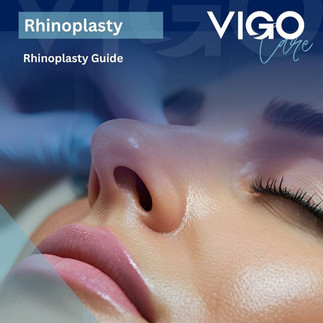Rhinoplasty - Guide to Rhinoplasty
- DrZAHER SAKKAL
- Oct 31
- 6 min read
Updated: Nov 1
Rhinoplasty - Guide to Rhinoplasty
This rhinoplasty guide will explain what rhinoplasty is, the main reasons why you might consider it, how the procedure is performed, and its costs.
Rhinoplasty is one of the most common and effective cosmetic procedures for improving the shape of the nose and its harmony with facial features, giving people a more attractive appearance and boosting their self-confidence. The field of rhinoplasty has witnessed significant advancements in recent years with the emergence of modern techniques and more precise and safer results. This rhinoplasty guide will also introduce you to some of the countries most renowned for performing rhinoplasty procedures worldwide.

Rhinoplasty Guide
Rhinoplasty is one of the most common cosmetic surgeries worldwide, aimed at improving the appearance of the nose or correcting its functional issues in a way that gives the patient a natural look that harmonizes with their facial features. In this article, we will take you on a comprehensive tour of everything related to rhinoplasty, from reasons and motivations to types, techniques, costs, and post-operative care.
What is Rhinoplasty?
Rhinoplasty is a surgical or non-surgical procedure aimed at modifying the shape, size, or angles of the nose or correcting congenital defects or those resulting from injuries. Its goals can be aesthetic, to improve the appearance of the face, or medical, to treat breathing problems or a deviated septum.
Reasons and Motivations for Rhinoplasty
The motivations for individuals to undergo rhinoplasty vary from person to person, but they often include:
Aesthetic reasons: such as a large nose, deviation, or lack of harmony with the face.
Medical reasons: such as difficulty breathing due to a deviated septum or congenital deformities.
Injuries or accidents: leading to deformities or fractures of the nose.
Improving self-confidence: as a harmonious appearance provides a sense of satisfaction and attractiveness.
Types of Rhinoplasty Procedures
There are several types of rhinoplasty, varying according to the goal and technique used:
Surgical rhinoplasty: involves modifying the bones or cartilage to correct shape or function and is performed under general anesthesia.
Non-surgical rhinoplasty (filler): relies on injecting substances like hyaluronic acid to correct curves or improve harmony, without surgery.
Open rhinoplasty: used when the doctor requires a clearer view of the internal structures, where a small incision is made between the nostrils.
Closed rhinoplasty: surgery is performed from inside the nose without any external incisions, suitable for simple to moderate cases.
Functional rhinoplasty: aims to improve breathing and treat a deviated septum or blockages in the airways.
Steps of the Rhinoplasty Procedure
Medical consultation: where the condition of the nose is evaluated, and the appropriate shape and expected results are determined.
Examinations and preparation for the surgery: including blood tests and imaging of the nose from various angles.
Anesthesia: may be general or local depending on the type of procedure.
Making adjustments: the doctor reshapes the bones or cartilage according to the established plan.
Closing incisions and applying a splint: to protect the nose and maintain its new shape during recovery.
Recovery Period After Rhinoplasty
The recovery period from rhinoplasty requires some care and adherence to the doctor's instructions, including:
Avoid touching the nose or sleeping on the face.
Avoid wearing heavy glasses for a period.
Reduce vigorous physical activities.
Use cold compresses to reduce swelling.
Regular follow-ups with the doctor to monitor results.
Swelling typically lasts from two weeks to a month, while the final result appears within approximately 3 to 6 months.
Results of Rhinoplasty
The final results show a harmonious and natural-looking nose that integrates with the facial features. Patient satisfaction rates with the results are very high, especially with modern techniques that provide greater accuracy and safety.
Risks and Complications of Rhinoplasty
Although the procedure is safe when performed by a qualified doctor, some rare complications may occur, such as:
Temporary swelling or bruising.
Light bleeding.
Temporary difficulty breathing.
Slight asymmetry in shape (correctable).
Cost of Rhinoplasty
The cost of rhinoplasty varies depending on the country, the surgeon's experience, and the type of technique used, but it generally includes:
Surgeon's fees and their team.
Hospital or clinic costs.
Type of anesthesia used.
Medical examinations and tests.
Costs are often higher for complex surgical procedures compared to non-surgical techniques like fillers.
Tips Before and After Rhinoplasty
Choose a qualified and experienced doctor for nose procedures.
Discuss realistic expectations with the doctor.
Stop smoking before and after the procedure.
Maintain a healthy diet to speed up recovery.
Adhere to the doctor's post-operative instructions to avoid complications.
Rhinoplasty is now considered one of the most common and successful procedures in the field of cosmetic medicine, combining aesthetic and functional aspects to provide the patient with a harmonious appearance and better breathing ability. With the advancement of modern medical techniques, the procedure has become safer, more precise, and its results closer to natural.
Frequently Asked Questions About Rhinoplasty
1. What is rhinoplasty?
Rhinoplasty is a surgical procedure aimed at improving the shape or function of the nose, whether for cosmetic or therapeutic reasons. The procedure involves modifying the size of the nose, correcting deviations, repairing congenital deformities or those resulting from injuries, as well as improving breathing if necessary.
2. Who are the suitable candidates for rhinoplasty?
Suitable candidates for rhinoplasty are those who have issues with the shape or function of their nose and wish to enhance their appearance or address breathing difficulties. Candidates should be in good health, have realistic expectations about the results, and be of an age where facial bone growth is complete.
3. What techniques are used in rhinoplasty?
Rhinoplasty can be performed using two main techniques: the open technique, where the surgeon makes a small incision at the base of the nose for full access to the internal structures; and the closed technique, where incisions are made inside the nostrils without leaving an external scar. The choice of technique depends on the patient's condition and the goals of the surgery.
4. Are the results of rhinoplasty permanent?
The results of rhinoplasty are often permanent, especially if the patient follows the doctor's instructions carefully during the recovery period. However, some cases may require minor adjustments later, and the natural aging process may slightly affect the shape of the nose over time after rhinoplasty.
5. Is rhinoplasty painful?
Rhinoplasty is typically performed under general or local anesthesia with sedation, so the patient does not feel pain during the surgery. After the procedure, the patient may experience discomfort, swelling, or bruising around the nose and eyes, but these symptoms are temporary and gradually subside over one to two weeks.
6. How long is the recovery period after rhinoplasty?
Patients usually need about a week of rest after rhinoplasty, and the splint or stitches can be removed after 7 to 10 days. Swelling and bruising gradually disappear over two weeks, but the final results of rhinoplasty become apparent after several months when all swelling has resolved.
7. What are the potential risks and complications of rhinoplasty?
Rhinoplasty is a safe procedure when performed in a specialized center by an experienced surgeon; however, some complications may occur, such as bleeding, infection, temporary breathing difficulties, or asymmetry in the shape of the nose. Most of these complications are rare and can be easily treated by following the doctor's post-operative instructions.
8. Does rhinoplasty affect breathing?
When performed correctly, rhinoplasty does not negatively affect breathing; in fact, it may improve airflow in some cases where there is a deviated septum. It is important to choose an experienced rhinoplasty surgeon to ensure aesthetic and functional results are achieved simultaneously.
9. What is the cost of rhinoplasty and what factors influence it?
The cost of rhinoplasty varies based on the surgeon's experience, the type of technique used, the complexity of the case, and the geographical location of the medical center. For an accurate estimate of the cost of rhinoplasty, it is advisable to have a personal consultation with a specialist to evaluate the condition and determine an appropriate treatment plan.
To learn everything related to rhinoplasty
Rhinoplasty in Azerbaijan
Rhinoplasty in Turkey
Rhinoplasty in Saudi Arabia
Rhinoplasty in the UAE
Rhinoplasty in Kuwait
Rhinoplasty in Egypt
Rhinoplasty in Syria
To communicate and obtain a free consultation service about medical tourism in Azerbaijan, contact us
General Administration - Main branch in Azerbaijan - Baku - Varovsky - Guzanfar Masabayeov Street - Villa No. 23
Tel.: 00994125602825
mobile 1 : 00994502126601
mobile 2 : 00994552958104
email info@vigo-care.com
website www.vigo-care.com










Comments